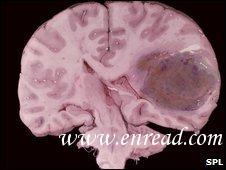| ||||||||||||||||||||||||||||||||||||||||||||||||||||||||||||||||||||||||||||||||||||||||||||||||
|
Genetic2 warning signs of an increased risk of the commonest kind of brain cancer have been discovered. 最普遍的一种脑癌的遗传性患病风险已经被发现。 Glioma is the most common form of brain tumour3 UK and US scientists identified genetic indicators4 that someone is at greater risk of developing a glioma(神经胶质瘤) - which accounts for 50% of all brain tumours5(肿瘤). However, the teams from London, Texas and California write in Nature Genetics that environmental factors also affect if someone will develop the cancer. A UK charity said the work opened up new avenues for research and treatment. About 4,550 people are diagnosed with brain tumours each year. Only 14% are alive after five years. Gliomas begin in glial cells(胶质细胞), which play a key role supporting and insulating(绝缘的) nerve cells in the brain. There are various kinds, with glioblastoma(胶质母细胞瘤) being the most aggressive, deadly and common. People who are diagnosed with it rarely survive more than five years. Analysis The two research teams looked at single nucleotide(核苷) polymorphisms(多形性) (SNPs). These are points in the genetic code which vary from person to person. In the first study, a team of scientists from London's Institute of Cancer and the University of Texas looked at over 521,000 SNPs in almost 1,900 glioma patients and 3,670 healthy people and found 34 SNPs linked with glioma. These 34 were then independently analysed by scientists in Germany, France and Sweden who looked at the DNA6 of 2,500 people with glioma and almost 3,000 healthy people. This allowed researchers to pinpoint7(精确地找到,准确地轰炸) 14 key SNPs on five genes8. As people have two copies of each gene1, one from each parent, they can have up to 10 of the variants9. The researchers said those who had eight or more were three times more likely to develop glioma than the general population. Professor Richard Houlston of the Institute of Cancer Research, who led the study, said: "This is a major discovery. "We've found the first real evidence that variations in the genes which many people carry can increase their risk of this deadly disease." The team hope their findings can eventually be used to help identify those most at risk for the disease and also to provide potential targets for treatment or prevention. 'Relative risk' In the second study, a team from the Mayo Clinic and the University of California San Francisco found a connection between DNA alterations10 on chromosome11(染色体) 9 and glioblastoma risk. They looked at the DNA of over 900 glioma patients, and 4,000 healthy people. It was found that people with three particular SNPs had a 50% increased risk of developing glioblastoma. The same section of chromosome 9 was one of the five points identified by the Institute of Cancer Research study. But the Mayo Clinic's Dr Robert Jenkins, who led the research, said having the SNPs did not mean someone was guaranteed to get the cancer. "Increased relative risk is just that - relative." A normal person's risk of developing a glioblastoma is about one in 10,000, but the researchers say the risk is about one in 7,000 for a person carrying one of these SNPs. However, scientists in both studies say further research is needed to confirm their findings, and that it is too early to screen people for the genetic variations. And Dr Lesley Walker, director of information at Cancer Research UK, which part-funded the UK study, said: "Compared with many other cancers, little is known about the lifestyle or genetic factors that influence the risk of developing brain tumours." She said it was important to "unlock" some of the "genetic secrets" behind glioma. "Identifying these genetic variants will open up new avenues for scientists to explore, helping12 them to better understand how gliomas develop, identify who might be most at risk and ultimately find improved ways to diagnose and treat the disease," she added. 点击  收听单词发音 收听单词发音
|
||||||||||||||||||||||||||||||||||||||||||||||||||||||||||||||||||||||||||||||||||||||||||||||||
- 发表评论
-
- 最新评论 进入详细评论页>>




